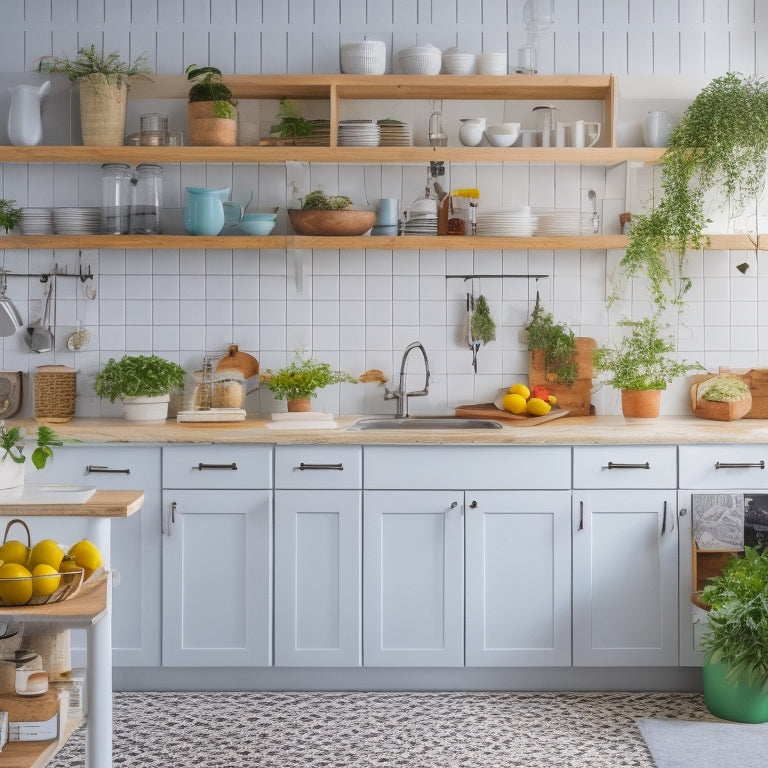
Simplify Kitchen Cleaning With 7 Essential Checklists
Share
You're tired of feeling overwhelmed by kitchen cleaning tasks. By breaking them down into 7 essential checklists, you can simplify your routine and get your kitchen sparkling. Start with daily quick pickups, like clearing countertops and wiping surfaces, to prevent crumbs and spills from building up. Next, focus on weekly deep cleaning tasks, like scrubbing the sink and stove, and monthly maintenance, like deep cleaning appliances. Don't forget to tackle seasonal organization, decluttering, and sanitizing best practices. With these checklists, you'll be able to stay on top of kitchen cleaning and maintain a hygienic space. Start streamlining your cleaning routine now and discover a more efficient you.
Key Takeaways
• Create a daily cleaning routine to maintain a clutter-free kitchen and prevent crumbs and spills buildup.
• Divide the kitchen into zones and assign weekly deep cleaning tasks to tackle dirt, grime, and clutter.
• Schedule monthly maintenance tasks to deep clean appliances, filters, and hidden compartments.
• Establish a sanitizing schedule to identify and clean germ hotspots, ensuring food safety and hygiene.
• Break down tasks into seasonal chunks to maintain a organized kitchen and prevent clutter buildup.
Daily Kitchen Quick Pickups
Set aside 10-15 minutes each day to tackle daily kitchen quick pickups, a habit that will greatly reduce clutter and make your kitchen a more enjoyable space. By incorporating this routine into your morning routine, you'll be amazed at how it sets the tone for a productive day.
Start by clearing off countertops, putting away dishes, and wiping down surfaces. This daily speed cleaning will prevent crumbs and spills from building up, making it easier to maintain a clean kitchen.
Next, take a few minutes to tidy up your kitchen sink and stove areas. Wipe down the sink basin, faucet, and stove with a damp cloth to remove any food residue or stains. Don't forget to quickly sweep or vacuum the floor to remove any debris.
Weekly Deep Cleaning Tasks
Now that you've got your daily quick pickups down, it's time to tackle the weekly deep cleaning tasks that'll keep your kitchen sparkling.
You'll want to focus on specific kitchen zones that need extra attention, and prioritize tasks based on your personal needs and preferences.
Kitchen Zones to Clean
Divide your kitchen into five zones - sink, stove, refrigerator, countertops, and floors - to tackle weekly deep cleaning tasks efficiently. This strategic approach helps you create a cleaning flow that's tailored to your kitchen layout, making the most of your time and energy.
Start by assigning specific tasks to each zone. For instance, the sink zone might include scrubbing the sink basin, faucet, and garbage disposal, while the stove zone involves cleaning the cooktop, oven, and range hood.
The refrigerator zone should cover the exterior, handles, and seals, as well as the interior shelves and drawers. Countertops require attention to crumbs, stains, and spills, while floors need sweeping, mopping, and sanitizing.
Deep Cleaning Priorities
Addressing deep cleaning priorities weekly guarantees that your kitchen remains hygienic, organized, and functional, as you focus on critical areas that require extra attention. By doing so, you'll prevent the buildup of dirt, grime, and clutter that can make your kitchen feel overwhelming.
To get started, prioritize tasks that have the greatest impact on your kitchen's cleanliness and functionality. For instance, dedicate one day a week to Fridge Organization. Remove everything from the fridge, wipe down shelves, and toss expired or spoiled food. Then, organize items into categories, such as dairy, meats, and vegetables, and store them in designated zones.
Another critical area is the pantry. Schedule a Pantry Purge to eliminate expired or unused food items, and organize remaining items by category and expiration date. This will help you identify what you need to restock and make meal planning easier.
Monthly Kitchen Maintenance
Now that you've got your weekly cleaning routine down, it's time to focus on monthly kitchen maintenance. You'll want to tackle deeper cleaning tasks that require a bit more effort, but will keep your kitchen in top shape.
This month, make sure to deep clean your appliances and schedule regular tasks to stay on track.
Deep Clean Appliances
Clean your appliances thoroughly once a month to remove built-up grime, food residue, and stains that can harbor bacteria and odors. This deep cleaning routine won't only keep your appliances looking like new but also extend their lifespan. By regularly cleaning your appliances, you'll guarantee they continue to function efficiently and effectively, which is essential for appliance longevity.
Here are some areas to focus on when deep cleaning your appliances:
-
Filters and vents: Clean or replace filters and vents to improve airflow and reduce dust and debris buildup.
-
Hidden compartments: Don't forget about forgotten features like crumb trays, ice makers, and condenser coils that need regular cleaning.
-
Seals and gaskets: Inspect and clean seals and gaskets to prevent moisture buildup and ensure a tight seal.
- Exterior surfaces: Wipe down exterior surfaces with a gentle cleaner to remove fingerprints, splatters, and stains.
Schedule Regular Tasks
To maintain a clean and organized kitchen, set aside a few hours each month to tackle routine tasks that keep your space running smoothly. This is where task management comes in – by breaking down larger tasks into smaller, manageable chunks, you'll be more likely to stay on top of kitchen maintenance.
One effective way to do this is through time blocking. Allocate specific timeslots for each task, and stick to it. Here's a sample monthly schedule to get you started:
| Task | Frequency | Time Required |
|---|---|---|
| Clean the oven | Monthly | 1 hour |
| Wipe down cabinets | Monthly | 30 minutes |
| Organize kitchen utensils | Monthly | 30 minutes |
| Deep clean the fridge | Bi-Monthly | 2 hours |
| Check expiration dates | Monthly | 15 minutes |
Seasonal Kitchen Organization
Shift your kitchen organization into high gear by tackling seasonal tasks that'll keep your cooking space running smoothly year-round. By breaking down tasks into seasonal chunks, you'll stay on top of kitchen maintenance and enjoy a more organized, stress-free cooking experience.
Here are 4 essential seasonal tasks to get you started:
-
Winter Refresh:
Take stock of your pantry and fridge, discarding expired or spoiled items. Clean and organize your kitchen cabinets, and consider investing in airtight storage containers to keep ingredients fresh. -
Spring Reset:
Deep clean your oven, stove, and refrigerator to remove built-up grime and food residue. Organize your kitchen utensils and gadgets, and consider donating or recycling items you no longer use. -
Summer Sanitize:
Focus on sanitizing high-touch areas like countertops, sinks, and faucets to prevent the spread of germs and bacteria.
-
Fall Fine-Tune:
Review your kitchen layout and workflow, making adjustments to optimize efficiency and functionality. Consider reorganizing your kitchen tools and equipment to streamline meal prep and cooking.
Kitchen Decluttering Essentials
Your kitchen decluttering journey begins with identifying the essential items you need to keep and the clutter you can eliminate. Start by gathering boxes or bins to sort items into 'keep,' 'donate,' and 'discard' categories. This simple step will help you develop a decluttering mindset, allowing you to tackle kitchen chaos with confidence.
Next, take everything out of your cabinets, drawers, and countertops. Yes, everything! This will give you a clear view of what you have and help you decide what stays and what goes. Be ruthless – if you haven't used it in the past year, it's probably safe to get rid of it.
Sort items into their respective categories, and don't be afraid to let go of duplicates or broken items.
Cleaning Schedule for Busy Days
Create a daily cleaning schedule that fits your busy lifestyle by breaking down tasks into manageable chunks, focusing on high-impact areas like the sink and stove. This will help you stay on top of kitchen cleaning even on the most chaotic days.
To make the most of your time, try time blocking during your morning rush. Allocate a specific time slot for kitchen cleaning, whether it's 10, 20, or 30 minutes. Here are some tasks you can fit into your daily schedule:
-
Morning Wipe-Down: Quickly wipe down the sink, stove, and countertops to remove any crumbs, spills, or splatters.
-
Dish Duty: Load the dishwasher or wash any dishes from the night before.
-
Trash and Recycling: Take out the trash and recycling to keep your kitchen smelling fresh and prevent pests.
- Countertop Organization: Spend a few minutes tidying up countertops, putting away appliances, and straightening up kitchen utensils.
Kitchen Sanitizing Best Practices
Proper kitchen sanitizing involves more than just wiping down surfaces, as it requires a deliberate strategy to eliminate germs and bacteria that can contaminate food and cause illness. You might think you're doing enough, but Sanitizing Mythbusters will tell you otherwise. It's time to debunk those myths and get real about sanitizing.
First, identify the Germ Hotspots in your kitchen, such as faucet handles, countertops, and sink drains. These areas are breeding grounds for bacteria and require extra attention.
Next, establish a sanitizing schedule to make sure you're tackling these hotspots regularly.
Don't just wipe down surfaces; sanitize them with a solution of water and bleach or a sanitizing product. Remember to always read labels and follow instructions.
You'll want to sanitize after every meal prep, especially when handling raw meat, poultry, or seafood. By following these best practices, you'll be well on your way to a germ-free kitchen. You got this!
Frequently Asked Questions
How Do I Organize My Kitchen Utensils and Gadgets Efficiently?
You categorize utensils by function, grouping similar items together, and station gadgets near their zones of use, freeing up counter space and streamlining your workflow, giving you more time for what matters.
What Are Some Eco-Friendly Alternatives to Chemical-Based Cleaning Products?
"Cut to the chase" and ditch harsh chemicals! You'll be "green" with joy using eco-friendly alternatives made with natural ingredients and sporting green labels, giving you a sparkling clean kitchen without harming the planet.
Can I Use a Dishwasher to Sanitize Baby Bottles and Toys?
You can sanitize baby bottles and toys in a dishwasher, but make sure the bottles are dishwasher-safe and the toys are labeled as such. For added peace of mind, check the manufacturer's guidelines on sterilization methods for bottle safety.
How Often Should I Replace My Kitchen Cleaning Supplies, Like Sponges?
"When in doubt, throw it out! You shouldn't hold onto worn-out sponges, as they can breed bacteria. Practice Sponge Safety by rotating your supplies every 1-3 months to maintain a clean and healthy kitchen, and don't let germs get a foothold through poor Supply Rotation."
Are There Any Kitchen Cleaning Tasks Suitable for Young Children to Help With?
You can empower your little ones by assigning kid-friendly chores, like wiping up crumbs or putting away toys, which are age-appropriate tasks that'll help them develop a sense of responsibility and teamwork.
Related Posts
-

What's the Best Way to Store Recipes Online?
You're ready to ditch the recipe chaos and streamline your collection with a digital storage solution. The best way t...
-

Streamline Your Kitchen With Digital Storage Solutions
By embracing digital storage solutions, you can transform your kitchen into a more efficient and clutter-free space. ...

